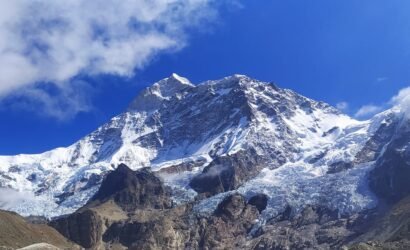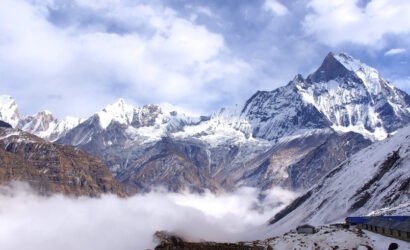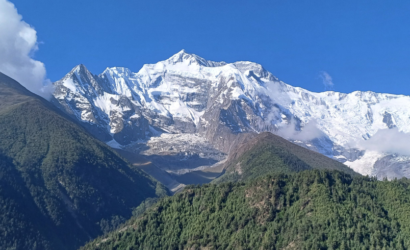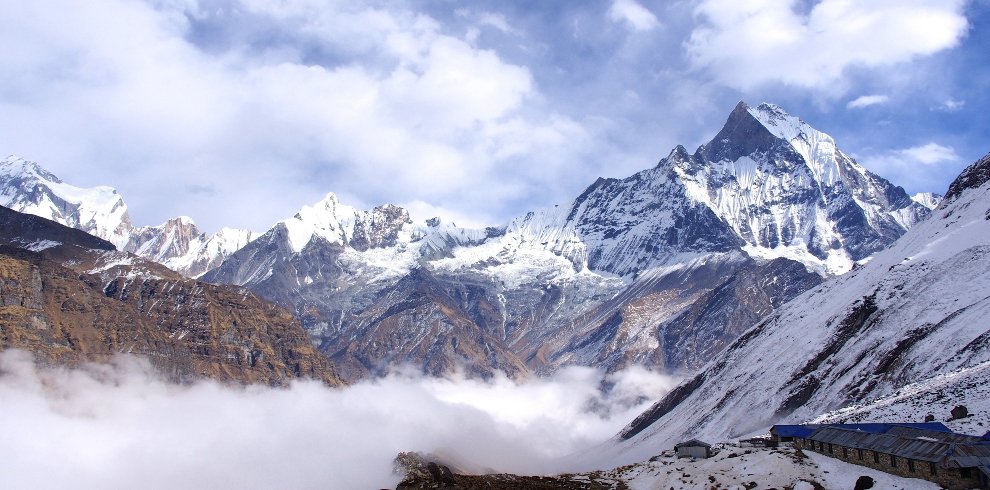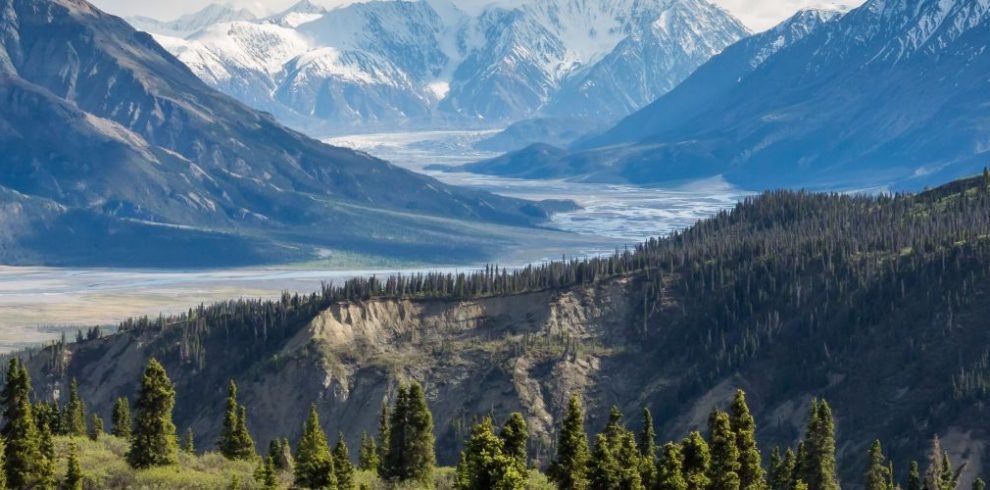-
Privat Transport, Airlines
-
3 Stars Hotels
-
4870 metres
-
Kathmandu
-
Mar, Apr, May, Sept, Oct, Nov
-
Trekking, Hiking
-
All meals during the trek
-
Moderate to Hard
-
2-8
Overview
Makalu Base Camp Trek is an adventure, offering a unique blend of cultural encounters, breathtaking scenery, and a physical challenge that will push your limits. This trek takes you far from the usual tourist trails and deep into the heart of eastern Nepal, where you’ll discover the rich traditions of the Rai and Limbu communities. As you pass through their villages, you’ll be welcomed with warm smiles and the chance to experience their distinct way of life. Higher up, the trail leads you through Sherpa villages steeped in Tibetan Buddhist culture, adding even more depth to your journey.
The trek is a feast for the senses, with landscapes shifting from the lush greenery of subtropical forests and terraced fields to the stark beauty of high-altitude alpine meadows and rugged terrain. Your destination, Makalu Base Camp, sits at 4,870 meters and offers an awe-inspiring view of Mount Makalu, soaring to 8,485 meters as the world’s fifth-highest peak. Towering peaks like Lhotse (8,516 m), Chamlang (7,319 m), and Baruntse (7,162 m) rise majestically around you, forming a breathtaking panorama that is sure to leave you in awe.
However, the Makalu Base Camp Trek is about more than just the views; it is also about the challenge. This trek is demanding, requiring careful preparation and proper acclimatization to conquer the high altitudes and tough terrain. Yet, for those who are up for the challenge, the rewards are immense: an unforgettable journey through some of the most untouched and stunning landscapes in the Himalayas and a deep connection with the vibrant cultures that call this region home.
Highlights of the Makalu Base Camp Trek
- Majestic Makalu Views: Prepare to be awestruck by the towering presence of Mount Makalu (8,485 meters), the world’s fifth-highest peak. Throughout your trek, you’ll encounter stunning viewpoints offering panoramic views of Makalu and its impressive neighbors, Lhotse (8,516 meters) and Chamlang (7,319 meters). These majestic peaks will captivate you, making each step of your journey unforgettable.
- Lush Landscapes: Immerse yourself in the rich and diverse environments of Makalu Barun National Park. As you trek, you’ll traverse through vibrant tropical forests, meander through lush valleys, and ascend into serene alpine meadows and high-altitude tundra. The park is home to an incredible array of biodiversity, including 25 species of rhododendrons, which paint the landscape in vibrant colors during the blooming season. Along the way, you’ll cross pristine rivers and experience the ever-changing landscape as you climb higher.
- Cultural Immersion: The Makalu region is a fascinating blend of cultures, where Sherpa, Rai, and Limbu communities each bring their unique traditions and languages to the landscape. While you won't find as many Sherpas here as in the Everest region, their influence is still felt, especially in the higher villages where their customs remain strong. As you trek through the lower areas, you'll pass through Rai and Limbu villages, where you'll get a glimpse into their Hindu and animistic practices, adding to the cultural richness of the journey. As you climb higher, you'll notice the subtle signs of Buddhism—prayer flags fluttering in the breeze and the occasional monastery tucked into the mountainside. This mix of cultural influences makes trekking in the Makalu region a truly unique and enriching experience.
- Remote Wilderness: Escape the well-trodden paths and embrace the solitude of Nepal’s untouched wilderness. The Makalu Base Camp Trek takes you deep into remote and pristine areas where you can fully connect with nature. The peacefulness of this isolated region, broken only by the sounds of nature, offers a rare opportunity for reflection and serenity.
- Challenging Adventure: Are you ready for a true adventure? This trek will push you to your limits as you navigate rugged terrains and rushing rivers and climb to challenging altitudes, culminating at the breathtaking Makalu Base Camp (4,870 meters). It’s a trek that tests your endurance and determination, but the rewards—breathtaking views, a profound sense of accomplishment, and unforgettable memories—are well worth the effort.
Itinerary
Upon arriving in Kathmandu (elevation: 1,465 meters ), you'll be greeted by the bustling energy of Nepal's capital. The city is a vibrant blend of ancient traditions and modern life. Spend the day exploring cultural landmarks like Swayambhunath, known as the Monkey Temple, and Pashupatinath, one of the holiest Hindu temples. The streets are alive with the sights and sounds of daily life, offering a perfect introduction to Nepal’s rich heritage.
Today, you’ll take a scenic 35 minutes flight to Tumlingtar (elevation: 410 meters) a small town surrounded by lush greenery. From there, a drive through rolling hills, terraced fields, and forested paths brings you to Num (elevation: 1,560 meters / 5,118 feet). The drive, which takes around 4-5 hours, offers distant views of snow-capped peaks and a glimpse into the daily lives of the Rai and Sherpa communities who call this region home. It’s a peaceful start to your adventure.
Today's trek takes you through lush, forested paths and across small streams, heading towards the village of Tashigaon (elevation: 2,100 meters / 6,890 feet). You will walk for approximately 3 hours to Seduwa, where you'll enjoy a delicious lunch at Tea House. After lunch, continue your journey for another 3-4 hours, following scenic trails as you make your way to Tashigaon. The trek is serene, accompanied by the soothing sounds of nature. Tashigaon, being the last Sherpa village on this route, provides a unique glimpse into Sherpa culture. Expect to walk for a total of about 6-7 hours today.
The trail today is steep as you climb through dense forests towards Khongma Danda (elevation: 3,500 meters / 11,483 feet). The ascent is challenging, taking around 6-7 hours, but the rewards are great, with the first glimpses of the majestic Makalu and other peaks. As you reach the ridge, you’ll find yourself in an alpine meadow with breathtaking views all around. The landscape changes dramatically, signaling your entry into high-altitude terrain.
Given the significant altitude gain, today is another acclimatization day. You can explore the surrounding area and enjoy the stunning mountain views. This rest day is crucial for adjusting to the altitude before crossing the high passes ahead.
A long and rewarding day awaits as you cross Shipton La Pass (elevation: 4120 meters ). The trek starts early, and you’ll be walking for approximately 6-7 hours. The trail is rocky and rugged, with steep ascents and descents that make this one of the more challenging days of the trek. The passes are often covered in snow, especially in early seasons, adding to the difficulty. After crossing the pass, you’ll descend to Dobate (elevation: 3,650 meters / 11,975 feet), where the landscape is a mix of rocky terrain and sparse vegetation. The views of Makalu (8485 m.), Chamlang (7,319 m.), and Baruntse (7,162 m) are .simply stunning, making the effort well worth it.
Today’s trek takes you into the heart of the Barun Valley, descending to Yangle Kharka (elevation: 3,557 meters / 11,670 feet). The trail follows the Barun River, surrounded by towering cliffs and dense forests. The valley is a haven for wildlife, and you might spot blue sheep or Himalayan birds. The landscape is a mix of rocky paths and lush greenery, with the sound of the river echoing through the valley. Expect to trek for about 5-6 hours.
As you continue trekking, the landscape becomes more rugged and barren, with fewer trees and more open views. You’ll walk through alpine meadows before reaching Langmale Kharka (elevation: 4,410 meters / 14,468 feet). The towering peaks of Makalu, Peak 6, and Peak 7 dominate the skyline, providing a dramatic backdrop to your journey. The air is crisp, and the scenery is awe-inspiring. This day involves 4-5 hours of trekking.
This is the day you’ve been working towards – reaching Makalu Base Camp (elevation: 4,870 meters / 15,978 feet). The trek is challenging, with rocky terrain and a noticeable increase in altitude. Expect to walk for about 4-5 hours. The reward is worth it as you arrive at the base camp, surrounded by some of the world’s highest peaks. Makalu stands tall and majestic, with Everest, Lhotse, and Baruntse also visible in the distance. It’s a moment of achievement and awe.
Spend the day exploring Makalu Base Camp, taking in the panoramic views of the surrounding mountains. The barren, rocky landscape is starkly beautiful, and you might spot high-altitude flora or even the elusive snow leopard. This is also a day to reflect on the journey so far and immerse yourself in the remote, otherworldly environment of the base camp.
You’ll retrace your steps back to Yangle Kharka, but with a new perspective on the landscape. The descent is easier, allowing you to take in the scenery at a more relaxed pace. The Barun Valley’s beauty is even more striking on the return journey, with its mix of rocky terrain and verdant forests. Expect to trek for about 6-7 hours.
Continuing your journey back, you’ll trek to Dobate, enjoying the familiar sights of the Barun Valley. The trail leads through forests and along the river, with the mountains as a constant companion. The descent is gradual, making for a comfortable day of trekking. Expect to walk for 5-6 hours.
Today, you’ll climb back up to Khongma Danda, passing by the lakes and ridges you crossed earlier. The ascent is challenging, but the views of the mountains make it worthwhile. As you reach Khongma Danda, you’ll be greeted by the familiar sight of the alpine meadows and the distant peaks. It’s a rewarding day, bringing you closer to the end of your trek. Expect to trek for 6-7 hours.
Long descent takes you back to Seduwa, retracing your steps through the forests and streams. The path is steep but scenic, offering views of the surrounding hills and valleys. Returning to Seduwa feels like coming home, with the Sherpa village welcoming you back. Expect to walk for 6-7 hours.
On your last day of trekking, you’ll head to Arun Third (elevation: 1,980 meters / 6,496 feet). After the trek, you’ll drive back to Tumlingtar. Enjoy the final views of the rolling hills and distant peaks as you travel. Once in Tumlingtar, relax and think about your fantastic adventure. Expect to trek for about 4-5 hours and then drive for 3-4 hours.
Fly back to Kathmandu, where the comforts of the city await. After days in the wilderness, the bustling streets and vibrant markets of Kathmandu offer a sharp contrast. Spend the day relaxing, shopping for souvenirs, or visiting any cultural sites you might have missed earlier.
As your journey comes to an end, you’ll leave Kathmandu with memories of towering peaks, serene valleys, and warm encounters with local people.
Cost
The Cost Includes
- All Private Transport
- Kathmandu to Tumlingtar Fight
- Accommodation in Kathmandu ( With Breakfast )
- Private Jeep Tumlingtar to Num, Arun Third to Tumlingtar
- Teahouse Accommodation during the Trek
- Meals during the Trek ( Breakfast, Lunch, Dinner )
- All Permits
- Experienced Trekking Guide
- Necessary Porter
- First Aid Kit
- Duffle Bag for Your Trek
- Satellite Phone
The Cost Excludes
- International Flights
- Nepal Visa Fees
- Meals in Kathmandu and Pokhara
- Personal Trekking Gear
- Travel Insurance
- Drinks and Snacks
- Tips for Guides and Porters
- Personal Expenses
- Laundry Services
- Phone and Internet Charges
- Battery Charging
- Hot Showers in Teahouses
- All the things that are not mentioned in the cost include
Map
Essential Information for Your Makalu Base Camp Trek
- Flights and Contingency Plan: When traveling back from Tumlingtar to Kathmandu, your flight may be canceled due to unpredictable weather or other reasons. In such cases, a backup plan involves taking a 5 to 6 hour drive to Biratnagar, where you can board a flight to Kathmandu on the same day. This alternative route helps ensure your travel itinerary stays on schedule despite weather disruptions.
- Limited Morning: Flights to Tumlingtar are generally limited, with only one or two flights scheduled in the morning. These flights are planned early to avoid the strong winds that develop later in the day, so planning for an early departure is crucial.
- Porter Weight Limits: Porters on your trek can carry up to 20kg of gear. We provide a duffle bag to help manage this weight, so please pack light to stay within the limit.
- Airline Baggage Allowance: The baggage allowance for flights to Tumlingtar is 15kg per person. If you need to bring more, excess baggage can be paid for at the airport, subject to availability.
- Passport Copy Required: To secure domestic flight tickets, you must provide a copy of your passport when booking your trek. Please ensure this is provided in advance.
- Unpredictable Weather: The weather in the Makalu region can change quickly. Your guide may need to adjust the itinerary for safety reasons, so flexibility and patience are essential throughout the trek.
- Drone Regulations: Drones are generally restricted in the Makalu region, and you must obtain a special permit to use them.
- Physical Fitness Requirement: The Makalu Base Camp trek is a physically demanding journey. You need to be in good physical condition to undertake this challenging trek. Proper preparation and fitness are essential for successfully completing the trek.
- Insurance Reminder: Ensure your travel insurance covers high-altitude trekking and emergency evacuation. This is essential for trekking in the remote and challenging terrain of the Makalu region.
Essential Permits for the Makalu Base Camp Trek
Before you set off on the Makalu Base Camp Trek, obtaining the necessary permits is essential to ensure a smooth and legal journey. Here’s what you’ll need:
Makalu Barun National Park Entry Permit:
- Purpose: This permit grants access to the pristine Makalu Barun National Park, a region celebrated for its unspoiled natural beauty and diverse ecosystems. The fees contribute to the park’s conservation and management efforts.
- Cost: This permit costs NPR 3,000 (around USD 25) for international trekkers.
Special Trekking Permit (Restricted Area Permit):
Purpose: A Special Trekking Permit is required since the Makalu Base Camp Trek crosses restricted areas. Issued by Nepal’s Department of Immigration, this permit allows you to trek through these controlled regions legally.
- Cost: The fee is USD 20 per person per week for the first four weeks, applicable around the year (January to December).
Altitude Sickness (AMS) on the Makalu Base Camp Trek
Trekking to Makalu Base Camp provides breathtaking scenery, but the high altitudes present serious challenges, even for those in top physical condition. Altitude Sickness, or Acute Mountain Sickness (AMS), can develop when your body has difficulty adapting to the reduced oxygen levels at elevations above 2,500 meters (8,200 feet).
Recognizing the Signs:
AMS can slowly manifest, presenting symptoms such as dizziness, nausea, headaches, shortness of breath, fatigue, and trouble sleeping. While these signs might start mild, they can rapidly escalate into more severe and potentially life-threatening conditions, including High-Altitude Cerebral Edema (HACE) or High-Altitude Pulmonary Edema (HAPE), both of which demand urgent medical attention.
Preventative Measures:
- Pace Yourself: The key to a successful trek in the Makalu region is a slow and steady ascent. Once you reach 3,000 meters (10,000 feet), aim to limit your elevation gain to no more than 300-500 meters (1,000-1,600 feet) per day. This gradual pace allows your body to acclimatize to the thinning air.
- Acclimatization Days: Incorporate acclimatization days into your trekking schedule, especially after significant elevation gains. These rest days are crucial, not just for healing but to help your body adjust to the altitude.
- Hydration is Key: Staying well-hydrated is vital for your health at high altitudes. Consuming plenty of water helps with acclimatization.
- Avoid Overexertion: While maintaining activity is essential, pushing yourself too hard can increase the risk of AMS. Keep a steady pace, and listen to your body—if you feel overly tired, it’s essential to slow down or take a break.
- Nourish Your Body: A diet rich in carbohydrates and calories will give you the energy to trek at high altitudes. Proper nutrition is vital for maintaining your strength and stamina.
- Consider Medication: Some trekkers take medications like Diamox (acetazolamide) to help prevent AMS. It’s important to consult with a healthcare professional before beginning any medication.
- Heed the Warning Signs: Always remain vigilant for symptoms of AMS. If you start to feel unwell, don’t hesitate to descend to a lower altitude—this could be a life-saving decision if your symptoms worsen.
By taking these precautions and being aware of how your body responds to the altitude, you can significantly reduce the risk of AMS and safely enjoy your trek to Makalu Base Camp.
Essential Gear for Your Makalu Base Camp Trek
For a successful journey on the challenging Makalu Base Camp Trek, having the right gear to ensure your safety and comfort is crucial. Below is a list of essential items you should pack for your adventure:
- Trekking Boots:
- Invest in sturdy, comfortable trekking boots with good ankle support. The rugged terrain of the Makalu region demands footwear that can handle steep and uneven trails.
- Clothing Layers:
- Base Layer: Moisture-wicking thermal tops and bottoms keep you dry and warm during cold mornings and nights.
- Mid Layer: Pack a warm fleece or a down jacket for insulation, which is crucial for the high-altitude environment.
- Outer Layer: A waterproof and windproof jacket and pants protect you from the elements, especially during sudden weather changes.
- Additional Layers: Lightweight, breathable shirts and trekking pants are ideal for warmer parts of the day when temperatures rise.
- Headgear:
- Warm Hat: A wool or fleece hat is necessary to keep your head warm in the colder conditions found at higher altitudes.
- Sun Hat: A broad-brimmed hat or cap helps shield you from the intense sun, especially at altitude.
- Neck Gaiter or Scarf: This versatile item adds warmth and protects against chilly winds.
- Gloves:
- Insulated Gloves: Waterproof, insulated gloves are crucial for keeping your hands warm and dry.
- Liner Gloves: Thin, moisture-wicking liner gloves can be worn underneath heavier gloves for added warmth.
- Footwear Accessories:
- Hiking Socks: Opt for insulating, moisture-wicking socks and consider using liner socks to prevent blisters.
- Gaiters are essential for keeping snow, mud, and debris out of your boots, especially in rougher terrain.
- Backpack:
- A durable, comfortable backpack (40-60 liters) with a rain cover will carry your gear and protect it from rain.
- Rain Poncho:
- A lightweight, waterproof poncho that can cover both you and your backpack in the event of sudden rain showers.
- Sleeping Bag:
- Bring a high-quality, four-season sleeping bag rated for temperatures as low as -15°C or even colder, depending on the time of year. Nights at high altitudes can be freezing.
- Trekking Poles:
- Adjustable trekking poles are invaluable for maintaining balance and reducing the strain on your legs during steep ascents and descents.
- Hydration System:
- Water Bottles or Hydration Bladder: To stay hydrated, you must carry at least 2-3 liters of water each day.
- Water Purification Tablets or Filters: Purify water from natural sources, as potable water may not always be readily available.
- Personal Care:
- Sunscreen and Lip Balm: Apply high SPF sunscreen to protect your skin from the intense UV rays at high altitudes.
- First Aid Kit: Include blister treatments, bandages, antiseptic, pain relief, and any personal medications you might need.
- Personal Hygiene Items: For personal care, pack biodegradable soap, hand sanitizer, a toothbrush, toothpaste, and toilet paper.
- Headlamp:
- A dependable headlamp and batteries are essential for safely navigating in low-light conditions, whether you’re camping or trekking along the trail.
- Sunglasses: Sunglasses with UV protection and side shields are essential to shield your eyes from intense sunlight and the reflective glare of the snow.
- Snacks and Energy Bars: High-calorie snacks and energy bars will help keep your energy levels up throughout the demanding trek.
- Navigation Tools: While your guide will handle navigation, having a map, compass, or GPS can be helpful for your peace of mind.
- Camera: Bring a lightweight camera to capture the breathtaking scenery, but consider battery life and weight.
- Powerful Solar Chargeable Power Bank: A powerful solar-chargeable power bank is essential for this trek, as most places along the route lack electricity. This will keep your devices, such as your camera, headlamp, and phone, powered throughout the journey.
- Altitude Sickness Medication: Consider bringing Diamox or another doctor-prescribed medication to prevent or treat altitude sickness, a common concern at high elevations.
- Cash: Carry small denominations of money for any purchases, tips, and tea house services, as ATMs are scarce in remote areas.
With these essential items, you’ll be well-prepared to tackle the Makalu Base Camp Trek’s challenging terrain and unpredictable weather, ensuring a safe and successful adventure.
FAQs
The Makalu Basecamp Trek is considered a challenging and strenuous trek. It involves trekking through rugged terrain, steep ascents, and high-altitude passes, reaching 4,870 meters at the base camp. Trekkers should expect to walk 6-8 hours per day on average, with some days being longer, depending on the terrain and altitude. The trail can be physically demanding, and the daily walking time and altitude can make it more challenging. Due to the high altitude, there is also a risk of altitude sickness, making proper acclimatization crucial.
The trek typically takes 18-22 days, depending on the chosen itinerary and acclimatization days. The journey starts from Tumlingtar and ends at Makalu Basecamp before returning.
The highest point on the trek is Makalu Basecamp, situated at an altitude of 4,870 meters (16,404 feet). Trekkers will also cross high passes, including the Shipton La (4,229 meters) and Keke La (4,127 meters).
You will need the following permits for the Makalu Basecamp Trek:
- Makalu Barun National Park Permit
- Restricted Area Permit
The best time to trek to Makalu Basecamp is spring (March to May) and autumn (September to November). These seasons offer the most stable weather, clear skies, and the best views of the mountains. Monsoon season (June to August) can be very wet, and winter (December to February) can be freezing with heavy snow.
The Makalu Basecamp Trek takes place in a restricted zone, meaning you must have a licensed guide and acquire the appropriate permits through an authorized trekking agency. Solo trekking is not allowed; a minimum of two trekkers is required to obtain a permit for restricted areas. These regulations are enforced to prioritize safety and ensure that trekkers receive proper guidance throughout their journey in this remote region. Also, hiring a porter to assist with carrying your gear is recommended, making the trek more manageable and enjoyable.
Accommodations on the Makalu Basecamp Trek consist primarily of basic tea houses and lodges. The facilities are minimal, with shared rooms, essential bedding, and communal bathrooms. Some areas may have limited amenities, so preparing for rustic living conditions is essential.
Tea houses along the trek offer simple, local meals like dal bhat (rice and lentils), noodles, momos (dumplings), chapati, and potatoes. The variety may be limited in higher altitudes, and carrying snacks and energy bars for extra sustenance is a good idea.
- Altitude Sickness: Trekkers need to be aware of the risks of altitude sickness. Proper acclimatization is crucial, and you should ascend gradually to avoid Acute Mountain Sickness (AMS).
- Physical Fitness: This trek demands a high level of fitness. It is advised to train and prepare physically before attempting the trek.
Solo trekking is not allowed. A restricted area permit must be issued to a minimum of two trekkers and obtained through a registered trekking agency. Hiring a licensed guide is required.
- Warm clothing (layers, down jacket, thermal base layers)
- Good-quality trekking boots
- Personal care items – Suns cream, Leap Balm
- Sleeping bag rated for cold temperatures
- Trekking poles
- Water purification tablets or filters
- medication for altitude sickness and first aid kit
- Snacks and energy bars
- Powerful Solar Chargeable Power Bank
- Rain Poncho
- Head Lamp
- Bag Pack
- Water Bottle
- Sunglasses
- Personal Hygiene Items – soap, hand sanitizer, a toothbrush, toothpaste, and toilet paper
No ATMs are available on the trail, so carrying enough cash from Kathmandu or Tumlingtar for extra expenses on the trek.
Most places along the Makalu Base Camp trek do not have regular electricity. Solar-powered lights are available in some areas, but it’s not reliable for charging. It’s highly recommended to carry a high-capacity, solar-chargeable power bank to ensure your devices stay powered throughout the trek.
Yes, all our guides and porters are covered by insurance. This insurance includes medical coverage and protection in case of accidents, ensuring their safety and well-being throughout the trek.
Our guides undergo rigorous training in first aid, leadership, and mountain safety. They are well-equipped to handle emergencies, provide support, and offer valuable insights into the trek and local culture.
We’ll give you a duffle bag to pack your essentials for the trek. Each porter is responsible for carrying the bags of two travelers, with a limit of 10 kilograms per person. So, each porter will handle up to 20 kilograms in total, ensuring your trek remains as easy and enjoyable as possible.
Tipping your guide and porter is encouraged and shows appreciation for their hard work and support throughout the trek. For the guide, 10$ -15$, and for the porter, 8$ – 12$ per day is advisable. The tip amount can vary based on your group’s size and the trek’s duration. We will provide detailed tipping suggestions during the pre-trip briefing in Kathmandu.
Yes, travellers typically need a visa to enter Nepal. Upon arrival at Tribhuvan International Airport in Kathmandu, you can secure a tourist visa. Visas are offered for 15 days, $30 for a 30-day visa, $50 or a 90-day visa $125, with payment required in cash (USD, EUR, or NPR). Be sure to have a valid passport for at least six months.
Yes, travel insurance is highly advisable. Ensure your policy covers high-altitude trekking (above 5,000 meters) and emergency evacuation, such as helicopter rescue, in emergencies.
Guides carry local cell phones, which you can use for calls if needed, with reimbursement for any associated costs. If you bring your phone, acquiring a local SIM card is another option, and our guides or representatives can assist you in obtaining one upon your arrival. For emergencies, we also use satellite phones to ensure reliable communication regardless of your location.
To book your Makalu Basecamp trek or any other trek, contact us directly through our website or email or visit our office in Kathmandu. After confirming the trek details, we will provide a booking confirmation with all the necessary information about your itinerary, inclusions, and next steps.
Yes, an advance payment is necessary to secure your trek spot. This helps us reserve your accommodation, flight, permits, and guide/porter services. The advance payment is typically 20-30% of the total trek cost, depending on your chosen package.
You can make the advance payment through the following methods:
- Bank Transfer: We will share our bank account details so you can transfer the amount.
You can settle the remaining balance either:
- Before Arrival: Pay the total amount before reaching Nepal via bank transfer or online payment.
- Upon Arrival: Pay the remaining balance at our office in Kathmandu before the trek starts. Payments can be made in cash (NPR, USD, EUR) or by credit card.
Yes, credit card payments incur a 3-4% processing fee to cover charges imposed by credit card companies.
Please let us know as soon as possible if you need to cancel your trek. Our cancellation policy generally permits a partial refund of the advance payment depending on when the cancellation occurs:
- More than 30 Days Before Trek: Full refund of the advance payment (minus bank or transaction fees).
- Within 30 Days of Trek: Partial refund (amount depends on how close the cancellation is to the trek date).
- No-Shows or Last-Minute Cancellations: No refund provided.
If you need to change your trek dates after booking, let us know as soon as possible. We will do our best to accommodate your request based on availability. Date changes are usually free, but additional fees may apply if changes are made close to the trek date due to already arranged services (e.g., permits, flight tickets, accommodation)
In cases of unexpected cancellations due to health issues or emergencies, we will strive to offer a refund or credit for a future trek based on the situation and timing. Travel insurance is highly recommended to cover such eventualities.





